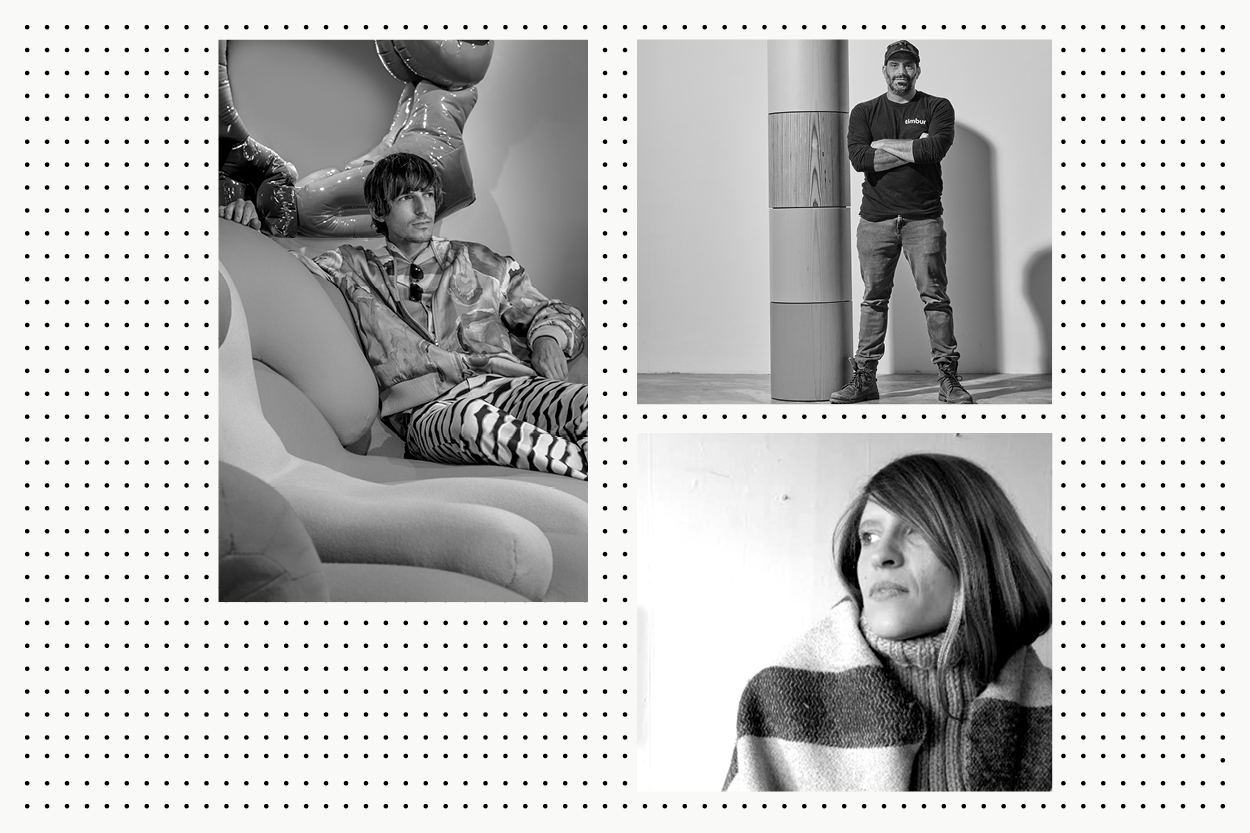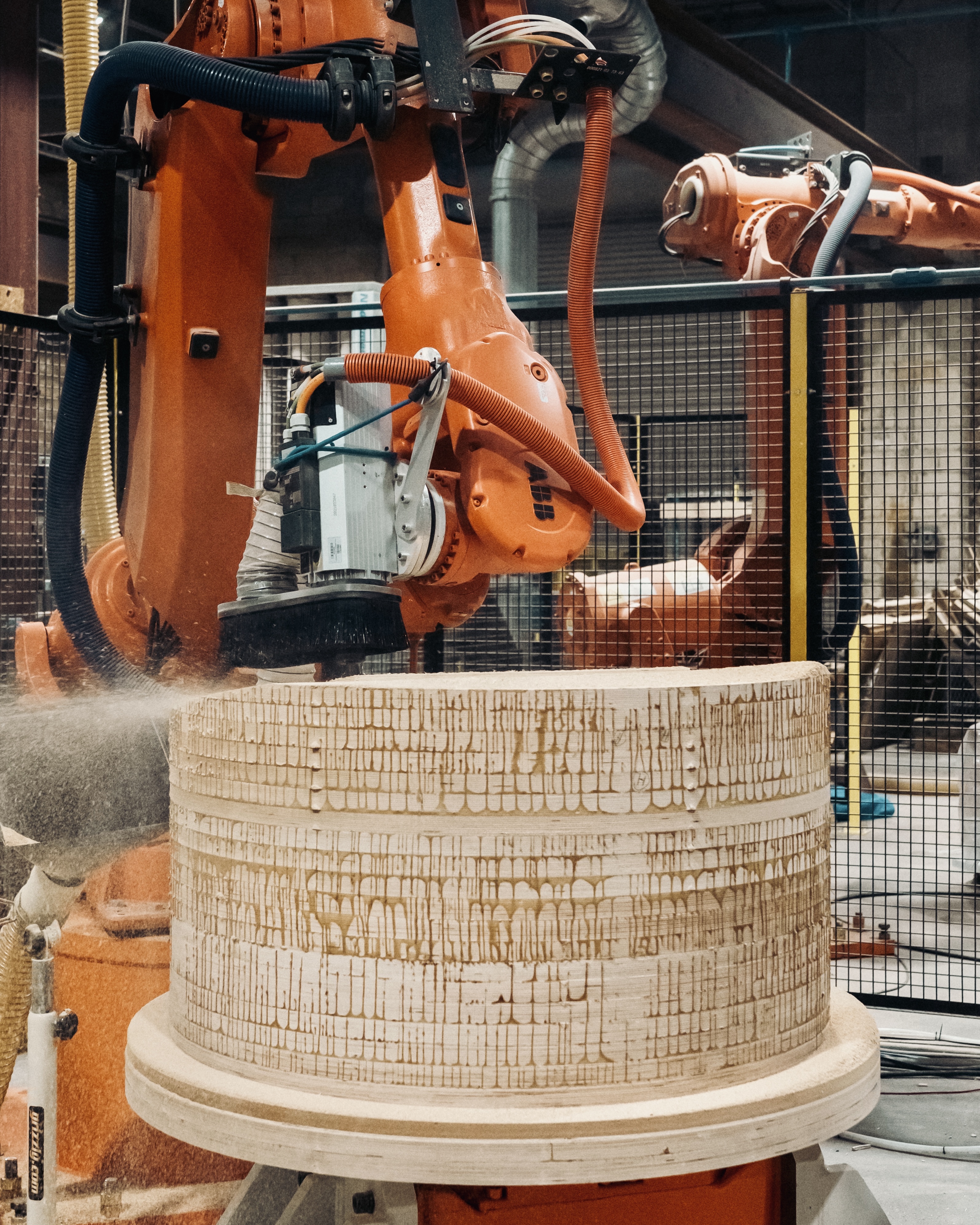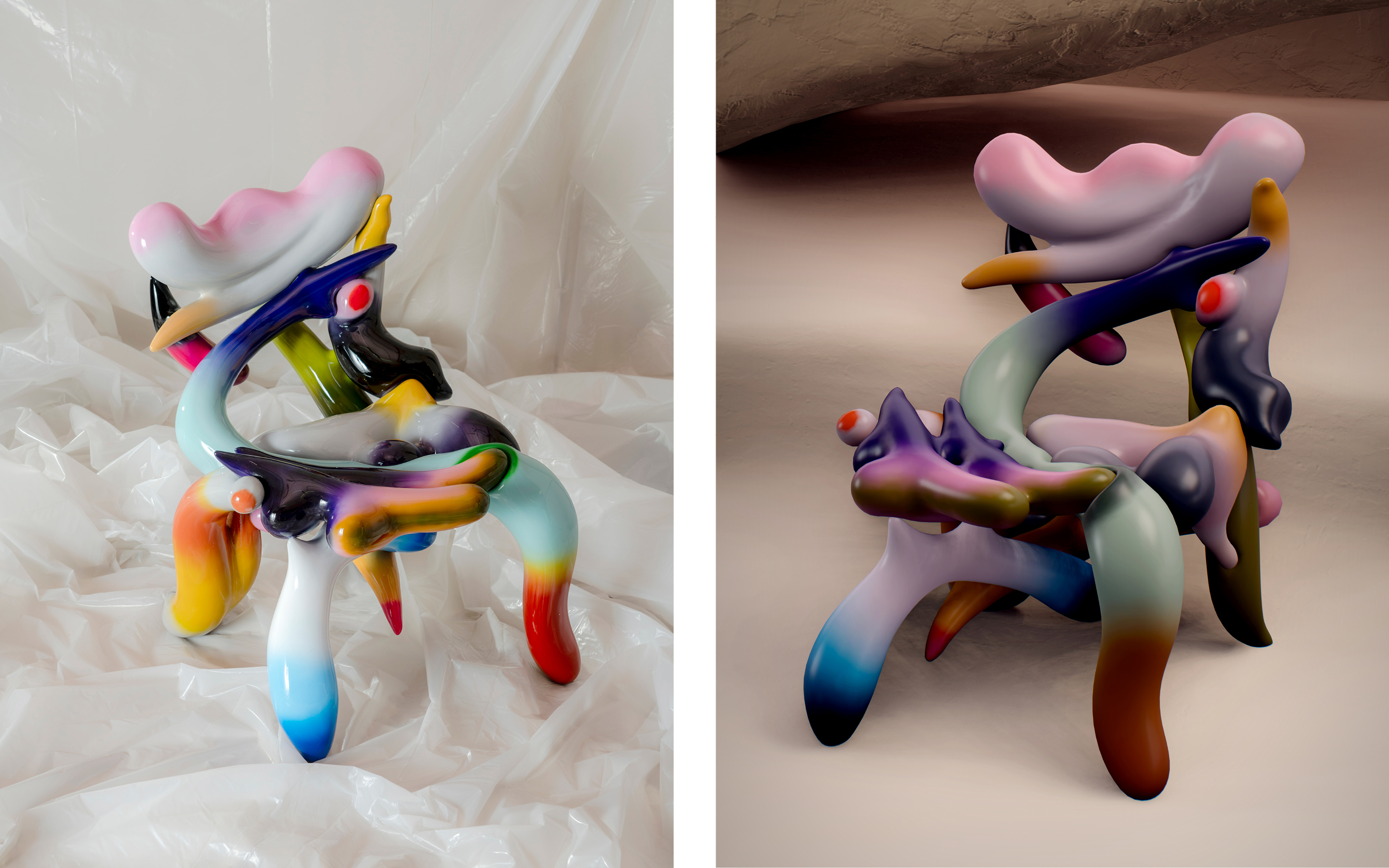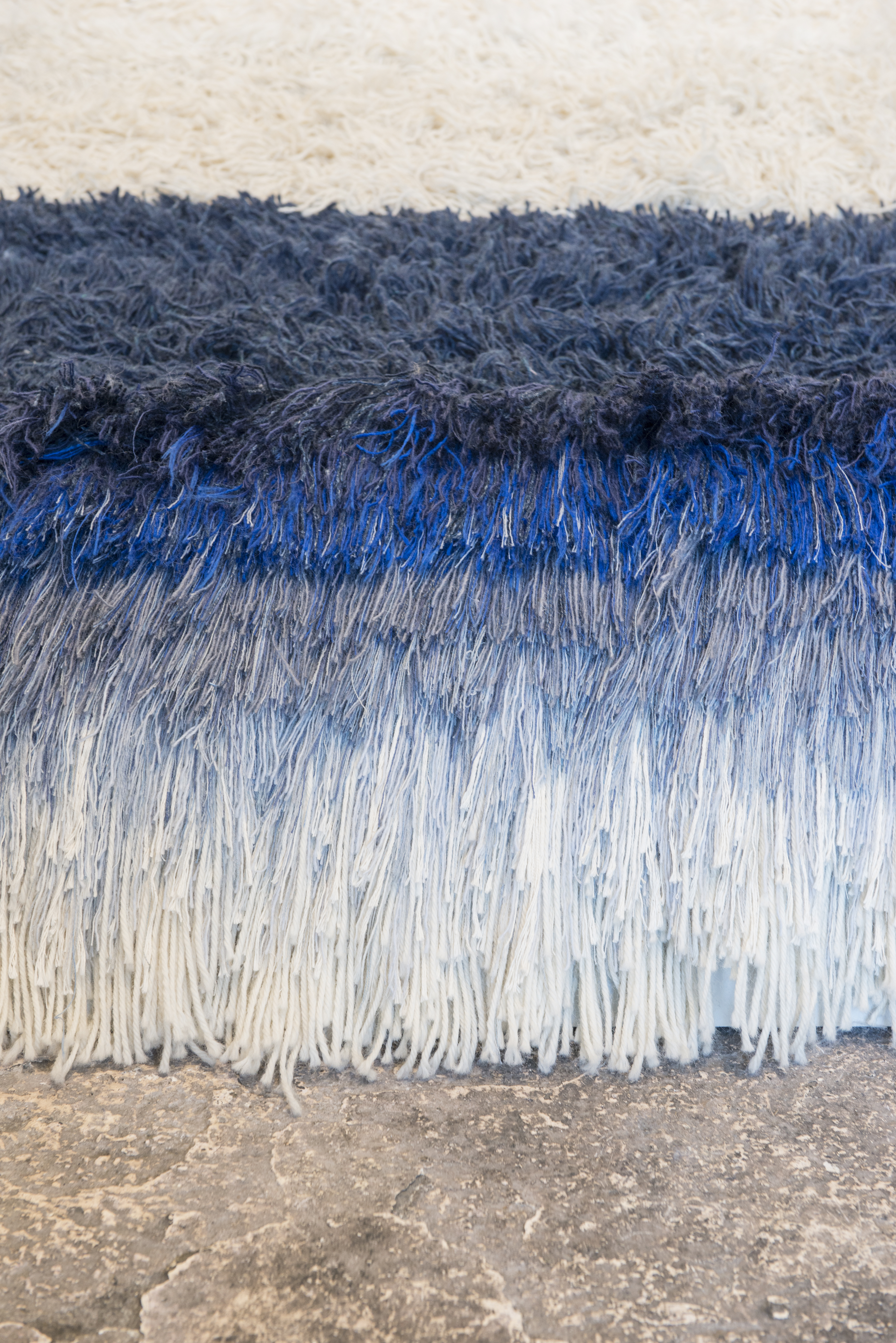DATE↓
STORY TYPE↓
AUTHOR↓
Designers Misha Kahn, Salem van der Swaagh, and Ezra Ardolino consider how technology is transforming their practice.

What does craft look like in 2023? As vast and varied as the internet experience, one might say. An act that once evoked visions of people bent over workstations, manipulating materials with the skill of a surgeon and the ability of an artist, now takes other forms, particularly as many practitioners think about how to augment traditional tools with the tools of tomorrow. Technology can be a means to extend their brains, bodies, and hands—those craft-centric appendages—and to expand their practices in ways that, until not long ago, involved too much time or too much complexity to bring to fruition or even think about. Now, they can.
To get real-time perspectives on the matter, I recently convened three people working with technology in the design industry in different ways—sculptor Misha Kahn, weaver Salem van der Swaagh, and Ezra Ardolino, founder of the digital-fabrication studio Timbur—for a conversation about craft and scale at Vitra’s Madison Avenue space in New York. (The sold-out, live discussion was part of the Swiss furniture maker’s monthly Salon Series.)
Their contrasting approaches to robots, machines, AI, and other devices reflected their diverse backgrounds: Kahn, who didn’t own a computer when he started out, years ago, began drawing in VR in 2020. The following year, Christie’s presented his work in “Furniture Unhinged,” the first design NFT sale offered by a major auction house, for which Kahn created an animation of a leaping, transmogrifying, psychedelic form. Ten stills from the video informed 10 NFTs, which owners could 3-D print or have Kahn make in real life. His digital experiments continue in his Brooklyn studio, where robots, 3-D printers, and other machines collaborate with human hands.
A textile designer and color specialist, Queens-based van der Swaagh studied at RISD and the Design Academy Eindhoven, and makes shaggy, highly texturized fabrics imbued with her belief that weaving is a potent vehicle for connecting with the environment they’re situated within. Previously based in Berlin, she has worked for a variety of design studios including JongeriusLab, Vitra, Kvadrat, and Knoll.
At Timbur, Ardolino blends high-tech and handmade. The New Jersey company uses its millwork shop, robotic machining, and CNC milling gear to produce its own line of furniture and to help clients—including the late architect Rafael Viñoly, the design gallery Friedman Benda, Nike, Bergdorf Goodman, and The Metropolitan Museum of Art—bring their ideas to life.
Audience members wanted to know the panelists’ thoughts on digital natives, the rise of fast furniture, and the potential for computer programs to overwhelm with seemingly infinite options. Their responses, like the rest of our dialogue, featured below, hinted at the nuance and intentionality with which designers might best use the inventions of our time.

In each of your practices, how do you define craft? MISHA KAHN: For me, the idea of craft has always felt like this knowledge that’s shared between the brain muscles. Something that’s really intuitive to do because you’ve done it a bunch. And then, when you go to do the task, it’s evident in the action. It’s a type of knowledge you can’t really get from a book—and with repetition, it gets deeper. SALEM VAN DER SWAAGH: I used to define craft as something that had to be made by hand. But in reality, that’s everything. Even an iPhone is made by hand to some extent. When I’m working, I become part of the process, part of the machine. The experience is hard to define, except in the sense of [being] in the moment. It’s a maker’s moment, I guess.EZRA ARDOLINO: You can define craft as a number of things, and I am happy for the word to have many meanings in different contexts. To me, craft is about taking something in the mind or the virtual world, and rendering it real in the physical world. That’s largely what I pursue in being creative, and that’s largely what the things I am surrounded by do. Tell me about how and why you incorporate technology—any kind of machinery, equipment, or other ways of applying scientific knowledge—into your work. Is it about efficiency? Experimentation? Idea-generation? Or something else?EA: My practice is entirely focused on the digital. That’s where it starts, and that’s the core of where things flow from. We have robots, CNC routers, all sorts of machines. Personally, it’s an obsession with working in a digital space, coupled with a desire to get that out into the world, and then using technology to figure out a way to do that. SS: Initially in my practice, I felt this great pride in shunning technology. Everything was incredibly labor-intensive and [done] by hand—and the more labor-intensive, the better. I wanted to connect with an ancient technology, and have it still be palpable in a contemporary material. Then I got into the industrial weaving realm, and realized the loom is the first computer. So I’m using ancient technology, and connecting with ancient weavers, but I’m also using a really phenomenal computer.
I know my machine really well: I can get underneath it, I can fix it, I know the right extensions for it. In that sense, my whole practice is about technology, because it’s about using a machine as an extension of my hand. In that regard, I’ve switched my perspective on what technology means for my craft. MK: Years ago, I didn’t own a computer. I was interested in how I could look at industrial processes and use an ad hoc approach that would yield individual, unique outputs. How could we start to make objects that don’t all look the same as each other?
At a certain point it became evident that technology could actually be so useful in that. It’s not usually the impetus of people with technology to do that, because we normally think of “efficiency” as, How quickly can we replicate the same thing?, rather than as, This is a tool, and it’s doing a good job.
So I did a deep dive into tech, and now I’ve been using virtual reality a lot as a sculpting tool, which, if you haven’t used it, is amazing. It makes drawing feel very degrading afterwards, because you can basically draw lines in space. Instead of having to draw something 2-D that’s trying to be 3-D, you can just draw the damn thing in 3-D in the first place. Lots of other technology unfolded from that as being a useful means to produce things. We use robots, we use 3-D printers, but the combination of how things go together is very useful. It’s a lot better to do some parts by hand, and others using technology. It’s very much a tool in the arsenal.

Do you worry that removing your hand from your process—not actually physically touching a piece—devalues your work? Or that people will think differently about your practice as technology’s role in it increases? MK: The way people think about it does change. But there were so many moments early on when I would outsource something to other craftspeople. You’d get something back, and realize that it was done at a higher level than you could do it. It’s so ecclesiastical to get your idea back better than you could do it.
Technology and other tools have basically given me and my studio the ability to do some of that ourselves: to be kind of shocked by something we made, which really sparks joy. It’s weird how society has hung onto the idea of the importance of the person making the thing needing to be the person who touched it, and then simultaneously divorced it so far, in the context of conceptual art, that it’s completely unnecessary. The truth is actually in the middle. A collaborative project that’s nicely conducted tends to yield the best work. EA: I’m sort of hand-biguous. [Laughter] In a certain sense, I don’t try to privilege or deny the hand. I mean, the hands are the tools that come with this particular life form. So it’s not necessarily about a particular organ; it’s more about a connection between how humans navigate the world and pick up information, and how ideas are manifested in reality.
In the shop, I might be working on something with my team and be like, “Throw a hammer on that.” Or, “Throw a meat tenderizer on it, until it’s smooth enough.” There is a role for that, and it’s worth acknowledging that that is how we connect with physical objects. At the same time, it doesn't necessarily mean that that’s the only way to make things. Right. But there are situations where incorporating technology into the production process can compromise the integrity of a craft. My favorite object I own, for example, is a spoon my friend carved out of wood. When I hold it in my hands, I can feel his soul transferred to the spoon, and then to me. Conversely, when I eat with my spoon made from West Elm, I don’t get that feeling.
How much of “the hand” is needed for an object to be considered craft? And at what point, when incorporating technology into the production process, do we lose it? MK: My spoon theory is that if West Elm were to arrive at your door and were like, “We made one spoon, and only one spoon, just for you,” it wouldn’t be as spiritual as your friend’s spoon, but it’d be a special spoon. I think there’s something there: The fact that a West Elm spoon means nothing to you because a person’s hand isn’t there has a lot to do with ubiquitousness, that something can’t be yours because it’s everyone’s. That’s a really interesting element to try and find a way to capture.
When you think about other things you love—and maybe it’s not even made by a friend or made specifically for you—what delivers is the kind of specialness of that item, and there’s a lot of ways to get there. But things made by hand do have a certain secret sauce, because it’s always going to be a little bit singular. SS: There’s an exclusivity conversation around that: what you can afford when it comes to craft and how you value that. I often value things in my home much more than what I paid for them. When something isn’t for everybody, it’s for an exclusive group. I think that’s a shame, and also that we then deem what is more affordable—often the industrially made thing—no longer special.
It’s also about what we’re conditioned to, and how we learn about design. In the design industry, we learn that things in our environment should not age. The fabric shouldn’t age; the leather shouldn’t age—although we value the thing we found on 1stdibs, where the leather’s been sat in for fifty years, more than we value a new piece. So there’s a gap in our education of how things are meant to feel, and how things are meant to age. EA: In my work, there’s not much of a connection to the handcrafted world. It’s important, though, in terms of where I come from. I went to school for architecture in the late nineties, and that was a digital form-finding time. All we did was sit around on computers and be like, “Oh, that’s wrinkly. Make it more wrinkly.” “Make it bigger.” “Make it smaller.” If someone asked us to create a model, we’d be like, What? Okay, I’ll bring out custom cardboard, try to measure it real close, and see what I can get. That was super frustrating.
I got hooked on the potential of what was happening in the digital world, and the desire to just get it out—hopscotch my way into it. In a lot of cases, you can use building with the hand as a model for something you build with technology. You use the way the hand operates, or the ways that things work from a historical perspective. Digital work is not completely devoid of an understanding of the context from which it comes, but making certain things involves a complexity that is often well beyond the human hand.That makes me think about all the stack lamination you do. With robots, you make these crazy shapes and textures that you wouldn’t be able to carve otherwise. EA: It’s not that you wouldn’t be able to do it. You can make anything with your hands if you put enough time and energy and money into it. Everything is possible, probably, that anyone can imagine doing. You have to have that kind of mindset, that it really is that wide open.
But when you start to work with technology as a way of getting to those objects, you free up your mind. What my mind’s doing on the computer is seeing things way faster than if I made them by hand. I could sit there and chip away at something for a while, and then step back and look, and then chip away for a while, and step back and look—that’s a certain kind of feedback process.
We decouple that. There’s a material aspect, where we understand the limitations of a material: Can it be like this? Can it be like that? I don’t know, let’s try. The material talks to you in a certain way, and then you’re over here in this digital space, and you’re trying to listen to a certain material practice that informs that realm. That feedback loop is fantastic, and probably plays a role in the scaling of work, but it’s not a direct one. That gets to the idea of using technology as a way to extend your body. EA: And to extend your sixth sense! Each of you have worked with brands on projects that need to be produced in quantities larger than one. What do companies need to produce well-crafted work, and to do it in a way that is both timely and in numbers that meet demand?EA: That’s tough. Sometimes it works really well, and sometimes it’s a nightmare. Especially when it’s on the edge of something that’s creative or experimental. But really, that’s our job. MK: I feel like the usual approach is, “I’ll just go to the factory and tell them what I want.” Or it’s a drawing, and everyone just, like, struggles to figure out how to make it. I have tried both of those approaches, and both have potholes.
The first one sort of ends up looking like everything else, because you’re just pandering to the tools. With the other one, everyone is, like, so miserable. Even if the product is really cool, it’s really hard to make, and everyone’s mad at you.
The real thing is, again, in the middle. It always sucks to be a centrist. But I feel like the best products have come when I was open-minded about what it would become, and kind of collaborative, inspired by the machinery and the equipment and the workflow. I’m always the person in the shop asking, “What’s something cool that you think would work that no one does?” And usually people working there are like, “Well, sometimes this happens.” There’s almost always something that they have ready for you to do no work and put your name on, basically. [Laughter] No, that’s the worst way of phrasing it…!SS: Brands want you to compromise. They want your design, and then they want you to compromise your design. MK: That’s real.SS: It’s this process of them really loving what you do, then asking, “Would you do it like this?”

What advice do you have for someone in that situation?SS: I would never advise someone to compromise. You’d never get anything made. I’m going through this process right now with a rug brand that produces its pieces in Nepal. They’re trying to standardize my design—not industrialize it—because weavers are sitting at their looms, weaving it. When I make a rug, or whatever I’m weaving, each one is different because I’m a reactionary designer: I do something, then I react to it, and then I do something else. The people in Nepal are not going to work that way; they are going to have a drawing they weave from, and every line has to be defined.
It’s a good push to figure out how I should communicate things. How do I get this company that’s comfortable in the graphic realm to do something textured? I start from that side of the conversation, versus forcing my agenda.
At the same time, I do think there is a really important moment of compromise that you have to just gear up for no matter what. It’s give and take: “This is not exactly what I wanted, but I am going to get fifty of them out in the world.” That’s the compromise. I want to shift our focus to the future. You can hardly read anything now that doesn’t eventually mention AI, which is a good example of something that is pushing the conversation forward around how little or how much we should resist new technologies that are coming into our lives. How ought people in the design industry approach such developments?MK: I think AI is great. 3-D is coming out soon, and it’s incredible. If you want a chair, you can just describe it, and the program will make it for you. It’s going to push people so hard. Most designers are doing the bare minimum. So if you’re just picking up crumbs on the floor, the computer has replaced you. Everyone’s going to have to really step it up, and I am so excited for that.
Currently as a 2-D tool, it’s so helpful to just be like, “Okay, I just need you to finish this part, or fill in this background a little bit over here,” and the tool can do it. For 3-D, it’s going to be explosive how quickly it’ll help us get to those kinds of solutions, and to be more adventurous. There are so many things we don’t do because it takes too many hours and becomes such a big inefficiency that, all of a sudden, are going to be possible. EA: AI will get mixed into our lives, and we will understand it better along the way. At Timbur, we’ve had discussions about the role of technology and the changes it makes for us, so we are very well prepared to deal with that. At the same time, I am not personally convinced by it. Like, the things that you get out of AI are pretty obvious. Ask it to make hands—it’s wonderful. It has no idea that a hand has four fingers and a thumb. [Editor’s note: Shortly after this conversation, AI generators figured out how to accurately render hands]. So does craft still matter?EA: Craft matters because it can be so many different things. It’s gonna be a really good way to take this conversation into the future. MK: We lived through almost a hundred years of production, building to sort of a churn. Now, humanity is ready for objects that matter. That’s craft.SS: Craft matters because we are in a constant state of trying to connect to one another on some level. Objects are a vehicle for connection and experience. Striving to connect in a physical body is limiting, and craft isn’t. It’s all encompassing, it’s never ending, and there’s never a moment when you’re done with it. The open-endedness of it: that’s important.
This conversation has been edited and condensed for clarity.